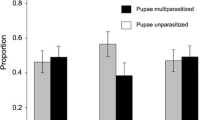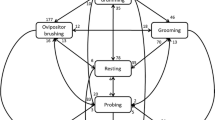Abstract
Field experiments with foraging parasitoids are essential to validate the conclusions from laboratory studies and to interpret differences in searching and host selection behaviour of parasitoid species. Furthermore, field experiments can indicate whether the parameters measured in the laboratory are relevant to elucidation of the ecological processes under study, such as adaptation or species interactions. In previous extensive laboratory studies we studied plant- and host-searching behaviour, host acceptance, host suitability; host plant preference, and learning of two congeneric parasitoids of Pieris caterpillars: the generalist Cotesia glomerata, which has been reported to attack several Pieridae species, and C. rubecula, a specialist of the small cabbage white Pieris rapae. In the present field study our aim was to verify the importance of these previous laboratory findings for explaining the performance of these two species in the field. We investigated experimentally whether parasitism on three Pieris species varied with parasitoid species and with food plant of the caterpillars. We exposed different types of host plants, infested with different Pieris species, to parasitism by natural populations of Cotesia species, by setting the experimental plants out in Brussels sprouts cabbage fields. Furthermore we made direct observations of parasitoid foraging in the field. In general, the field results confirmed our predictions on the range of host plant and host species used in the field. The two Cotesia species appear to coexist through niche segregation, since C. glomerata was mainly recovered from P. brassicae and C. rubecula from P. rapae. Although C. glomerata is a generalist at the species level, it can be a specialist at the population level under certain ecological circumstances. Our study shows the importance of variation in host plant attraction and host species acceptance in restricting host plant and host diet in the field. Furthermore the results suggest that, at least in the Netherlands, specialisation of C. glomerata on P. brassicae may occur as a result of C. rubecula outcompeting C. glomerata in P. rapae larvae.
Similar content being viewed by others
Author information
Authors and Affiliations
Additional information
Received: 8 July 1999 / Accepted: 31 January 2000
Rights and permissions
About this article
Cite this article
Geervliet, J., Verdel, M., Snellen, H. et al. Coexistence and niche segregation by field populations of the parasitoids Cotesia glomerata and C. rubecula in the Netherlands: predicting field performance from laboratory data. Oecologia 124, 55–63 (2000). https://doi.org/10.1007/s004420050024
Issue Date:
DOI: https://doi.org/10.1007/s004420050024




